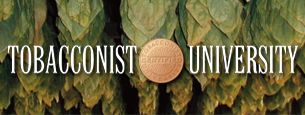AIR-CURING
After harvesting/priming, the mature tobacco leaves are delivered to air-curing barns, usually located adjacent to the fields. The leaves are tied in pairs and hung on lathes in giant barns designed to circulate air and dry out the leaves. Air-curing times vary for different varietals [and priming levels] of tobacco, but this process will take approximately two months. Temperatures and humidity will be constantly monitored to ensure the tobacco transforms properly.
Air-curing will fix the sugar levels, halt the maturation process, and release moisture and chlorophyll from the leaves. Air-curing is complete when the leaf and stem turn completely brown and the leaf exhibits leather-like elasticity when stretched. But keep in mind, these leaves are far from done; they are full of ammonia and cannot be smoked without causing an unpleasant reaction. And now you know why cigar tobacco is called dark air-cured. Click here to learn more about air-curing and other related curing methods...
FERMENTATION
After air-curing the leaves will be sorted by size, texture, priming level, and other criteria. Now the leaves are ready for their biggest and most important transformation - fermentation. Fermentation is a natural organic process that accounts for the majority of change and distinction in cigar tobaccos. Its like a natural slow cooking process where the moistened tobacco heats up under its own weight and off-gasses ammonia and other impurities. Fermentation can last weeks or months, depending on the varietal/priming/texture.
Every pile of similarly grouped tobacco leaves will be intricately assembled, allowed to increase in temperature and then disassembled and re-assembled: effectively rotating the hot spots. This will continue until all of the leaves are thoroughly fermented. Fermentation is as much an art form as it is a science! Every cigar manufacturer has a different technique, temperature specifications, piling technique and approach to the process. But two things are certain, fermentation expels what you don't want in the tobacco and exposes its true organoleptic potential. Click here if you would like to learn more about fermentation...
MADURO FERMENTATION
While the term maduro can simply refer to a color designation for wrappers, it is also the process of fermenting tobacco more vigorously and for a longer period of time: this will yield a richer and sweeter leaf. Click here to learn more...
AÑEJAMIENTO
After fermentation the leaves will become darker and they will again be sorted by texture, size, color, priming level and other criteria. Then they will be packed up and stored to age until they are ready to become part of a premium cigar. The name for this aging/storage process is añejamiento.



















No comments :
Post a Comment